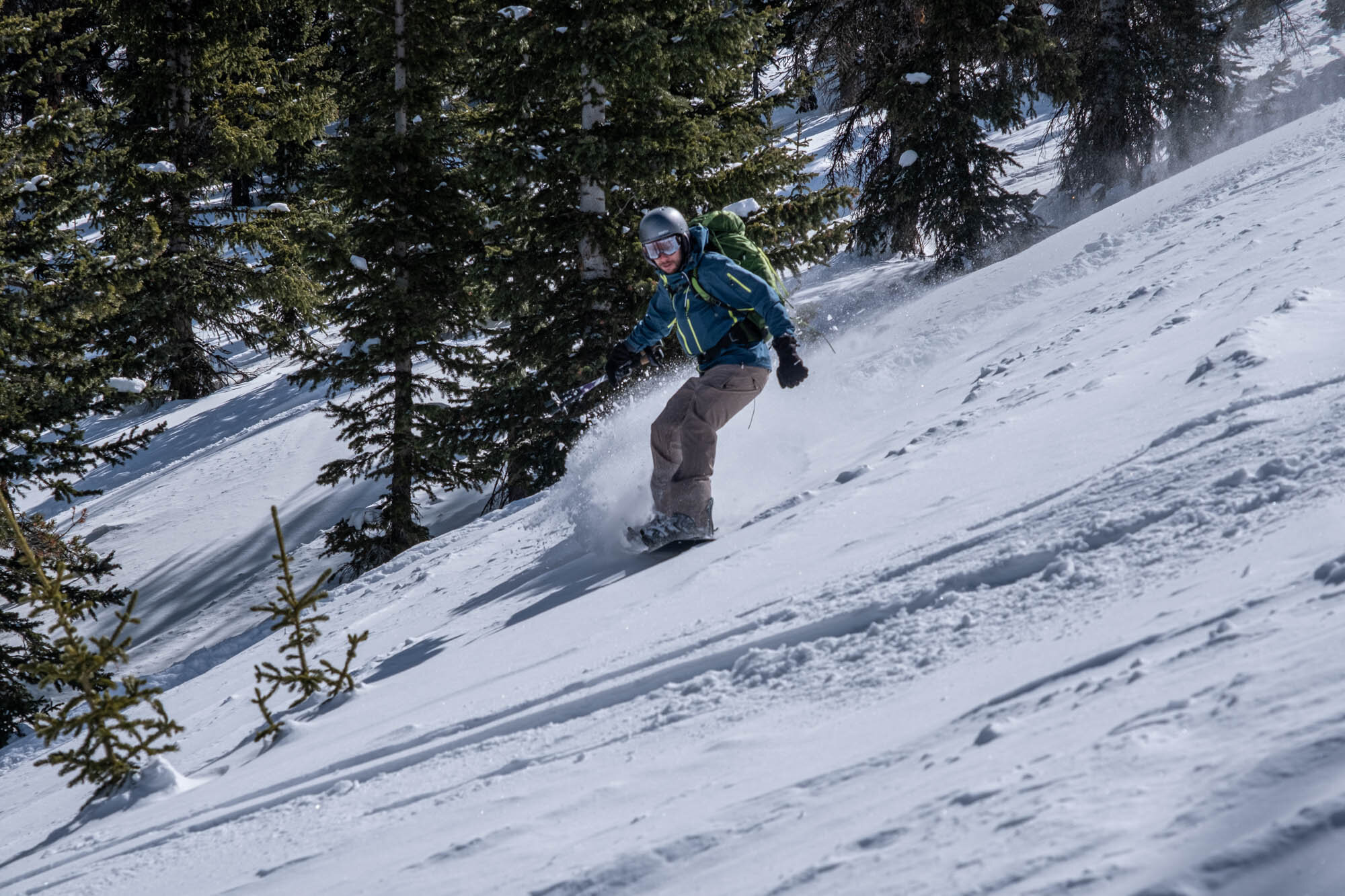Which backcountry course is right for you?
As ski and ride season approaches, resort and backcountry enthusiasts alike are getting excited and preparing for the arrival of snow! Whether it’s your first or third season getting out of the resort and into the backcountry, there are a variety of educational opportunities to keep you exploring safely and successfully. These options can seem daunting, but ultimately two courses teach the basic skills, knowledge, and risk management strategies essential to getting started with your winter backcountry adventures: Intro to Backcountry Skiing and Riding courses and AIARE Avalanche Education courses.
Intro to Backcountry Skiing and Riding
Intro to Backcountry Skiing and Riding Courses focus on gear familiarization, uphill movement, skiing variable snow conditions, and basic avalanche awareness. Whether skiing or snowboarding, learning to transition from uphill to downhill travel involves a series of practiced skills such as putting on and taking off climbing skins, switching bindings from walk to ski, or switching between splitboard to snowboard. Our experienced instructors will offer tips and tricks for using gear safely and efficiently so you can maximize your turns!
In addition, in the Intro to Skiing and Riding Course, you’ll learn the basic movement necessary for backcountry travel. Instructors will coach how to choose an effective route uphill by reading the snow-covered terrain, deciphering features, knowing what to avoid, and setting a good pace. Your instructors will teach kick turns to maintain momentum and cut smooth skin tracks as you journey uphill. They will also provide tips for cruising the short downhill sections with your skins on or when your board is in split mode – skills that often feel odd and wobbly at first! Finally, when it comes time to make some turns, this introductory course also provides ski and splitboard development for the variety of snow conditions encountered in the backcountry. From deep powder to crusty or windblown snow, the variable snowpack provides even the seasoned skier or snowboarder the opportunity to learn new techniques.
Throughout the Intro Course, you will also learn basic avalanche awareness. While this is not specifically an avalanche education course, avalanche danger is the most significant risk to winter backcountry travelers. You will learn a brief overview of tools for checking the predicted avalanche danger each day, slope angles and aspects to be cautious of, and the essentials to keep yourself safe while still adventuring in the backcountry – and since avalanches are no joke, you will be told to go take an Avalanche Education course if you plan on recreating often in the backcountry during winter.
AIARE Avalanche Education
Because the Intro Course only touches the surface of avalanche awareness, AIARE Avalanche Education courses are essential for learning how to make good decisions while enjoying backcountry slopes. These courses are built as a progression that teach a repeatable risk management system, coach the use of trip planning tools and resources, and explore snow science, weather, and terrain information. AIARE 1 gets students started with a foundation, AIARE Avalanche Rescue teaches essential beacon and probe skills in the event of an avalanche, and AIARE 2 advances and solidifies decision-making knowledge and abilities.
In each AIARE Avalanche Education course, you will review and practice a repeatable risk management system so that it becomes like muscle memory, whether you are proactively planning for an adventure or reactively using rescue skills in an emergency. Not exclusive to skiing or riding, this foundational skillset can be utilized anytime you are traveling in the backcountry. It allows you to identify risks, understand the consequences and likelihood of those risks, and make plans to mitigate or avoid them. In addition to research and resources from snow scientists, AIARE courses implement essential trip-planning tools, including the introductory use of a map, an overview of digital mapping tools, and coaching on how to use these tools on the go to effectively route find around avalanche terrain.
One of the most engaging aspects of the AIARE Avalanche Curriculum is the exploration of snow science principles, winter weather patterns, and the impact of these on existing terrain features. As it gets deeper into winter, snow that falls at different times or in different conditions forms layers; the strength or weakness of these layers, and of the snowpack as a whole, is impacted by a variety of factors, such as snow moisture and temperature. When a layer is weaker, snow is more likely to break or slide, creating an avalanche. While this is an oversimplified explanation, AIARE curriculum helps you understand how to identify some of those layers, as well as provides resources from experts for knowing weather patterns that drive changing snow conditions and instabilities. In addition, in an AIARE course, you will learn how to identify avalanche terrain based on factors like slope angle, slope aspect, and other features in your surroundings.
As you can see, both Intro to Backcountry Skiing and Riding Courses and AIARE Avalanche Education Courses provide skills and knowledge necessary for safe, efficient, and fun winter backcountry travel, but they meet vastly different needs. Intro to Backcountry Skiing and Riding Course provides basic skills and techniques. AIARE Avalanche Education enables you to practice discerning when and where you can ski or ride safely.
Ready to sign up for a course?
If you’re interested in getting into the backcountry this winter and learning new skills, consider taking our Intro to Backcountry Skiing/Splitboarding Course or one of our AIARE Avalanche Education Courses with BVMA’s experienced instructors! We'd love to help you acquire and develop the skills you need to be safe and have fun in the Colorado backcountry.





